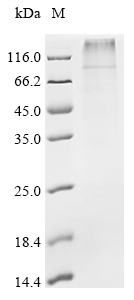Recombinant Pig Potassium voltage-gated channel subfamily KQT member 1 (KCNQ1)
CAT:
399-CSB-CF871323PI-01
Size:
20 µg
Price:
Ask
- Availability: 24/48H Stock Items & 2 to 6 Weeks non Stock Items.
- Dry Ice Shipment: No




Recombinant Pig Potassium voltage-gated channel subfamily KQT member 1 (KCNQ1)
- CAS Number: 9000-83-3
- Gene Name: KCNQ1
- UniProt: Q9TTJ7
- Expression Region: 1-673aa
- Organism: Sus scrofa
- Target Sequence: MAAATSPPRAERKRWGGGRLPGARRGSAGLAKKCPFSLELAEGGPTGGALYAPIGPPGVPGPSSPAAPAASPAAADLGPRPRVSLDPRVSIYSARRPLLARTHIQGRVYNFLERPTGWKCFVYHFAVFLIVLVCLIFSVLSTIEQYVALATGTLFWMEIVLVVFFGTEYAVRLWSAGCRSKYVGIWGRLRFARKPISIIDLIVVVASMVVLCVGSKGQVFATSAIRGIRFLQILRMLHVDRQGGTWRLLGSVVFIHRQELITTLYIGFLGLIFSSYFVYLAEKDAVNESGQVEFGSYADALWWGVVTVTTIGYGDKVPQTWVGKTIASCFSVFAISFFALPAGILGSGFALKVQQKQRQKHFNRQIPAAASLIQTAWRCYAAENPDSSTWKIYVRKPSRSQALLSPSPKPKKSVMVKKKKFKLDKDNGLSPGEKMLAVPQITCDLASEEQRPDHFSVDGCDNSVKKSPTLLEVSTAQFTRTNSFAEDLDLEGETLLTPITHVSQLREHHRATIKVIRRMQYFVAKKKFQQARKPYDVRDVIEQYSQGHLNLMVRIKELQRRLDQSIGRPALFISSSEKVKDRGSNTIGARLNRVEDKVTQLDQRLELITDMLQQLLSLHRGGTPGSRAPGGGGAQVAQPCSGGSINPELFLPSNALPTYEQLTVPGRGPEEGS
- Tag: N-terminal 10xHis-tagged
- Source: in vitro E.coli expression system
- Field of Research: Cardiovascular
- Assay Type: CF Transmembrane Protein & Developed Protein
- Relevance: Potassium channel that plays an important role in a number of tissues, including heart, inner ear, stomach and colon. Associates with KCNE beta subunits that modulates current kinetics. Induces a voltage-dependent by rapidly activating and slowly deactivating potassium-selective outward current. Promotes also a delayed voltage activated potassium current showing outward rectification characteristic. During beta-adrenergic receptor stimulation participates in cardiac repolarization by associating with KCNE1 to form the I (Ks) cardiac potassium current that increases the amplitude and slows down the activation kinetics of outward potassium current I (Ks). Muscarinic agonist oxotremorine-M strongly suppresses KCNQ1/KCNE1 current. When associated with KCNE3, forms the potassium channel that is important for cyclic AMP-stimulated intestinal secretion of chloride ions. This interaction with KCNE3 is reduced by 17beta-estradiol, resulting in the reduction of currents. During conditions of increased substrate load, maintains the driving force for proximal tubular and intestinal sodium ions absorption, gastric acid secretion, and cAMP-induced jejunal chloride ions secretion. Allows the provision of potassium ions to the luminal membrane of the secretory canaliculus in the resting state as well as during stimulated acid secretion. When associated with KCNE2, forms a heterooligomer complex leading to currents with an apparently instantaneous activation, a rapid deactivation process and a linear current-voltage relationship and decreases the amplitude of the outward current. When associated with KCNE4, inhibits voltage-gated potassium channel activity. When associated with KCNE5, this complex only conducts current upon strong and continued depolarization. Also forms a heterotetramer with KCNQ5 that has a voltage-gated potassium channel activity. Binds with phosphatidylinositol 4, 5-bisphosphate.
- Purity: Greater than 85% as determined by SDS-PAGE.
- Activity: Not Test
- Length: Full Length
- Form: Liquid or Lyophilized powder
- Buffer: If the delivery form is liquid, the default storage buffer is Tris/PBS-based buffer, 5%-50% glycerol. If the delivery form is lyophilized powder, the buffer before lyophilization is Tris/PBS-based buffer, 6% Trehalose, pH 8.0.
- Reconstitution: We recommend that this vial be briefly centrifuged prior to opening to bring the contents to the bottom. Please reconstitute protein in deionized sterile water to a concentration of 0.1-1.0 mg/mL.We recommend to add 5-50% of glycerol (final concentration) and aliquot for long-term storage at -20℃/-80℃. Our default final concentration of glycerol is 50%. Customers could use it as reference.
- Molecular Weight: 75.5 kDa
- Storage Conditions: The shelf life is related to many factors, storage state, buffer ingredients, storage temperature and the stability of the protein itself. Generally, the shelf life of liquid form is 6 months at -20℃/-80℃. The shelf life of lyophilized form is 12 months at -20℃/-80℃.
